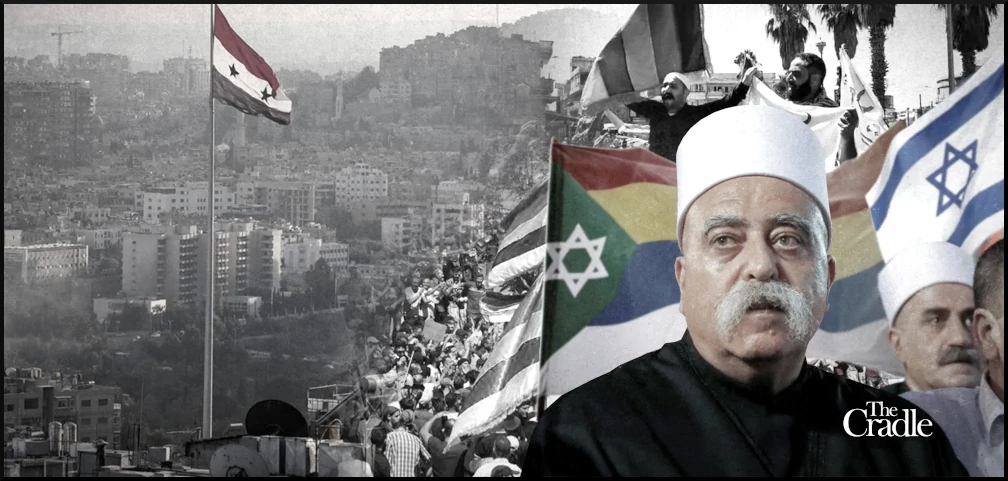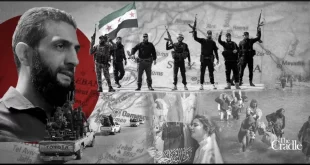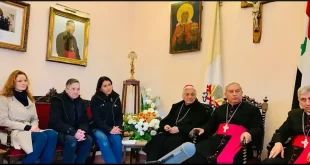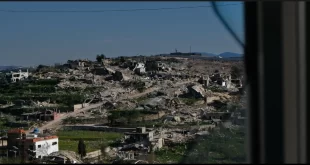by William Van Wagenen, published on The Cradle, September 18, 2023
On 17 August, anti-government protests erupted in Suwayda, a province in southern Syria with a Druze-majority population. These demonstrations were triggered by the Syrian government’s decision to lift fuel subsidies, which came amidst a severe economic crisis exacerbated by US economic sanctions.
Hundreds of Syrians burnt tires, blocked roads, and chanted anti-government slogans in Al-Karama Square in Suwayda’s city center.
Protesters shouted, “Long live Syria and down with [Syrian President] Bashar al Assad,” which, according to Reuters, echoed “chants from 2011 pro-democracy protests that were violently crushed by security forces and sparked a long-running conflict.”
References to the protests in 2011, and the bloody 12-year war that followed are important, but not for the reasons Reuters suggests.
Suwayda then and now
Contrary to the mainstream view, the anti-government demonstrations in 2011 were not popular, peaceful protests demanding democracy. As detailed elsewhere, the protests were sparked by US and allied intelligence agencies seeking regime change in Damascus. The CIA and Saudi intelligence flooded Syria with Al-Qaeda militants from Iraq and Lebanon who infiltrated protests to attack Syrian police, soldiers, and security officials.
As in 2011, the hand of foreign intelligence agencies is evident in the Suwayda protests taking place today.
According to an informed source speaking with The Cradle, the protests are driven primarily by groups enjoying support from US and Israeli intelligence, namely the Men of Dignity and the Brigade Party.
According to the source, “everyone is aware of the role they played and continue to play” in Suwayda.
The Men of Dignity, or Rijaal al-Karama, group was formed by an obscure Druze religious figure, Wahid Balous, shortly after the US-led covert war on Syria began in 2011.
“Balous was an unknown cleric before the [war],” one of his associates told The New Arab in 2015. Three years earlier, “His name began to emerge with the rise of armed groups affiliated to sheikhs who said they were neither in the opposition nor the pro-government camp.”
Al-Jazeera also reported in 2015 that “Syria’s Druze are not fully supportive of Balous,” including some who “questioned his political agenda.”
“He openly declared himself opposed to Israel, but his close relations with Israeli Druze, who are linked to Israeli intelligence and the military establishment, raised fears that he might have been manipulated,” said one activist from Suwayda, quoted by the Qatari outlet.
The informed source speaking with The Cradle also highlights the role of Israeli intelligence in establishing the Men of Dignity with the help of Israeli Druze figures.
“The Men of Dignity are influenced and mobilized by the Mossad, and there is a role for Sheikh Mowafaq Tarif, the head of the spiritual council for Israeli Druze,” the source states.
Israeli involvement in Druze affairs
While the Druze community in Suwayda and in the Israeli-occupied Golan Heights are traditionally strong supporters of the Syrian government, some Druze elements in Israel are Zionists and support the Jewish state.
Sheikh Mowafaq Tarif has publicly expressed his strong support for Zionism and the Israeli state, while prominent Druze politician Ayoob Kara is a member of the Likud Party, founded by former Israeli Prime Minister Menachem Begin.
Given this context, it’s not surprising that Israel has been involved in efforts to sow chaos and promote separatism among the Druze in Syria, as outlined in Oded Yinon’s 1982 plan of breaking up Baathist Syria into ethnic mini-states, including a Druze state, as a primary Zionist objective.
As part of the establishment of the Men of Dignity in 2012, Balous established a militia allegedly devoted to protecting the Druze community during the ongoing war between the government and foreign-backed Salafist armed groups, including the so-called Free Syrian Army (FSA) and Al-Qaeda-affiliated Nusra Front.
According to sources from Suwayda speaking with Al-Jazeera, Balous commanded between 500 and 1,000 fighters.
This can be compared with the strength of the pro-government Druze militias active in Syria at the time.
Al-Jazeera notes that roughly 8,000 Druze fighters were then affiliated with the National Defense Forces (NDF), the Popular Committees, Dara al-Watan (Shield of the Homeland), and the armed wing of Syrian Social Nationalist Party (SSNP).
According to the informed source speaking with The Cradle, Balous’ militia obtained their weapons from Israel via the Nusra Front – since rebranded as Hay’at Tahrir al-Sham (HTS).
This claim is plausible given Israel’s well-documented collaboration with the FSA and Nusra Front
In 2014, opposition activists close to the FSA acknowledged the Israeli air force bombed Syrian army positions in Quneitra near the Golan Heights in support of Nusra.
Between 2015 and 2017, reports from the Wall Street Journal and UN peacekeeping troops patrolling the Golan Heights border fence revealed that Israel was supporting Nusra and allied FSA factions in southern Syria. Israel provided funds to pay salaries and buy weapons for armed groups while bringing Nusra fighters across the Golan border fence for treatment in Israeli hospitals.
Anger at Israeli support for Nusra caused Druze residents in the town of Majdal al-Shams, located on the Israeli side of the Golan border fence, to attack Israeli ambulances carrying Nusra fighters.
Israeli support for Nusra was further documented by the Druze activist Sidqi al-Maqt, who also hailed from Majd al-Shams. Maqt had been imprisoned for 27 years by Israel for resisting its occupation of the Golan Heights.
After his release in 2012, Maqt documented contacts between the Israeli army and Nusra in posts on social media. As a result, he was arrested again in 2015 and spent another five years in an occupation prison.
Collaboration and conscription
In June 2015, Balous and his militia were criticized for undermining the Syrian army and collaborating with the Nusra Front. At the time, Syria’s Druze community was facing its worst threat from the Israeli-backed Nusra Front and allied FSA since the start of the war.
Al-Jazeera reported that “Some criticized [Balous’] attacks on government checkpoints, and according to sources in Sweida, many questioned the absence of his militia when armed opposition groups launched a large-scale attack on the Thaaleh airbase in Sweida.”
Balous’ collaboration with the so-called rebels of Nusra and the FSA was evidenced further by a report from the Lebanese Daily Star. The Lebanese paper reported that “FSA spokesman, Yassin al-Hariri, pledged that if Thaaleh airport is seized by the rebels, it will be turned over to Balous’ Dignity Sheikhs group.”
The Nusra and FSA attack came at a sensitive time, as Nusra had massacred 20 Druze civilians in Idlib governorate in northern Syria the day before. In the months prior to the massacre, Nusra fighters had destroyed historic Druze graves and shrines in Idlib and forced hundreds of Druze to covert to Sunni Islam.
The massacre came as the western and Persian Gulf media launched a propaganda campaign to rebrand Nusra and describe it as a moderate group deserving western military support, despite its ties to Al-Qaeda.
Prominent Lebanese Druze politician Walid Jumblatt played his part. Following the massacre, he refused to condemn Nusra as a terrorist group, instead claiming, “The terrorist regime of Bashar obliged the Syrians to join Nusra.”
While Balous and the Men of Dignity refused to join the effort to protect Suwayda, Druze fighters in the NDF, Dara al-Watan, and SSNP helped the Syrian army recapture the Thaaleh airbase.
At the same time, large numbers of Druze youth were joining the Syrian army following a plea from Druze religious leader Hikmat al-Hijri.
Balous took a different stance. In a speech circulated online, he called on Druze youth to refuse conscription into the army, even though President Assad had made commitments that Druze recruits would remain in Suwayda to protect their own communities.
While seeking to undermine the military defense of Suwayda, Balous’ Men of Dignity organized anti-government protests that included the slogan, “The people want the downfall of the governor [of Suwayda],” Atef al-Nadaf.
Syria expert Aymenn al-Tamimi notes that in response, pro-government elements accused Balous and his followers of “orchestrating the demonstrations as part of a prior agreed plan to destroy the regime in Suwayda through collusion with foreign intelligence and Jabhat al-Nusra.”
In September 2015, Balous was assassinated in a bomb attack along with 25 others, including several Men of Dignity leaders in the Zhahr al-Jabal region.
Although it is not known who killed Balous, it is widely suspected the head of Military Intelligence in Suwayda, Colonel Wafiq Nasser, ordered the bombing. Balous had called for the “citizen’s arrest” of Colonel Nasser three months prior.
Rallying behind the flag
The informed source speaking with The Cradle also pointed to the role of Hezb al-Liwa, or the Brigade Party, in the protests that erupted in Suwayda recently. The group was founded in July 2021 and led by journalist Malik Abu Khair.
In an interview with Al-Monitor, Abu Khair said the party receives no foreign funding and that its political vision called for resolving the Syrian crisis in accordance with the US-backed UN Resolution 2254, which calls for a new constitution, elections, and the removal of President Assad from power.
However, according to the informed source, Abu Khair resides in France, and the party is funded by Qatar, France, and Britain:
“Those who called for protests in the squares were the Brigade Party and the Men of Dignity. They are the ones who raise the Druze flags and demand the implementation of UN Resolution 2254, and they offer dollars to those who join the Syrian Brigade Party or work with them.”
A militia affiliated with the Brigade Party, the Counter Terrorism Force (CTF), was also established in Suwayda in 2021.
Nowras Aziz, an independent journalist from Suwayda residing in France, told Al-Monitor that the CTF militia “was formed of members with criminal records, militia fighters and former security contractors with the military, as well as members of gangs that carry out kidnappings and demand ransom. Those are known locally and deeply hated.”
The Kurdish and Jordanian roles
The Brigade Party and affiliated CTF have received support from the US military and allied Kurdish forces operating out of the Al-Tanf base on the Syria-Jordan-Iraq border.
Journalist Nowras Aziz added that Brigade Party leader Abu Khair “had contacted the [US-led international] coalition forces at Al-Tanf base in the second half of 2020,” explaining his plan to take full control over the eastern villages of Suwayda province and remove “any presence of the Syrian regime or Iran in that area.”
Sources in Suwayda speaking to pro-opposition Syria TV confirmed the Brigade Party and CTF received funding, arms, and training from the Kurdish-led Syrian Democratic Forces (SDF) and the US military. This included help in establishing bases under SDF supervision in the eastern countryside of Suwayda.
The sources added that the CTF militia received six months of training from US forces stationed at the Al-Tanf base, under the pretext of combating Iranian militias and drug trafficking.
Because the US base at Al-Tanf is located on the Jordanian border – in close proximity to Suwayda – this suggests the US is using Jordan as a staging ground to support Druze separatism in Syria. The US military has already established 16 military bases in the Hashemite Kingdom, and there is talk about establishing a NATO office in the country.
It is widely acknowledged that the US, Israel, and Saudi Arabia used Jordan as a staging ground to support the FSA and Nusra during the war to topple the Syrian government starting in 2011.
Additional evidence for a US and Israeli-backed separatist project in Suwayda emerged in July, roughly one month before the recent protests erupted. As Syria TV reported in July 2023:
The “Syrian Brigade Party announced the establishment of service institutions alternative to those affiliated with the Syrian regime, indicating its desire to establish an independent self-administration for the Druze community, similar to the special regions of northeastern Syria, which are predominantly Kurdish.”
Syria TV further noted that the Brigade Party’s separatist project is “met with widespread opposition” in Suwayda, including from political and civic organizations, most of the local armed factions, and prominent religious leaders.
This suggests the current protests organized by the Men of Dignity and Brigade Party are supported only by a minority of Druze in Suwayda.
However, as in 2011, the western media has focused its attention on the few hundred protesters waving colorful flags and chanting slogans against President Assad to suggest the majority of Syrian Druze back regime change.
In light of the recent protests, the source speaking to The Cradle observes that:
“What caught my attention is an important detail: the raising of the Druze flag. During the protests since 2011, the Druze flag has not been raised at all. This flag-raising indicates preliminary steps that may lead to a separatist movement similar to that undertaken by the Kurds.”
Syrian Druze religious leader Sheikh Yusef Jarbou made a reference to the prominence of the Druze flag in the protests during a meeting with Suwayda notables on 30 August, one week after the protests began.
Sheikh Jarbou rejected calls by some of the protestors for separatism and the overthrow of the Syrian government, while stating that the flag of the Syrian state is the flag that he represents, and that siding with Damascus is the “strategic and national choice.”
Additionally, not all protesters in Suwayda are seeking regime change, as media reports typically imply.
Prominent Syria expert Joshua Landis of the University of Oklahoma explained that “most of the protesters are calling for more government activity in the economic life of the country, rather than a collapse of the government.”
“They want more electricity, they want subsidies, they want better schooling, they want the currency to be stabilized. They are desperate. They want higher salaries,” Landis said.
Crushing Syria through sanctions
It remains to be seen whether US and Israeli efforts to turn the Druze community against the Syrian state will succeed.
As journalist Aaron Mate observed, US planners are waging an economic war against average Syrians, hoping a collapse in living standards will turn them against the government.
Andrew Tabler, a former senior US official for Syria policy, boasted in 2021 that US sanctions have caused Syria’s currency to collapse, leading to “corresponding cuts in regime subsidies that have exacerbated fuel and food shortages for everyday Syrians.”
The threat of economic collapse comes as pro-Israeli voices are calling for the establishment of a “Free Druze Province” in Suwayda, bound by the Israeli-occupied Golan Heights to the west, the Al-Tanf base to the east, and US and Israel-allied Jordan to the south.
Damascus-based journalist Vanessa Beeley warns that the stage is now set for a possible US-Israel military intervention.
She reports that according to Syrian security sources, the US is gathering mercenaries at Al-Tanf in preparation to seize Suwayda and the border crossings with Jordan.
If such an intervention takes place, Israel will be one step closer to achieving the goal of dividing Syria into weak, ethnic mini-states, as articulated by Oden Yinon some four decades ago.
William Van Wagenen has a BA in German literature From Brigham Young University and an MA in Theological Studies from Harvard Divinity School. You can read more of his writings at the Libertarian Institute. Follow him on Twitter @wvanwagenen.
 Syria Support Movement solidarity with the Syrian people
Syria Support Movement solidarity with the Syrian people





